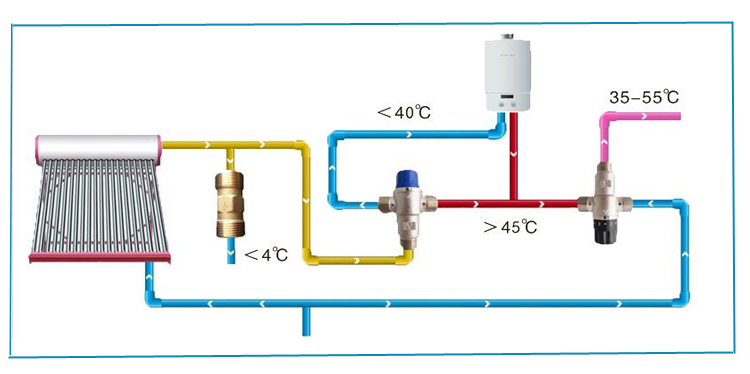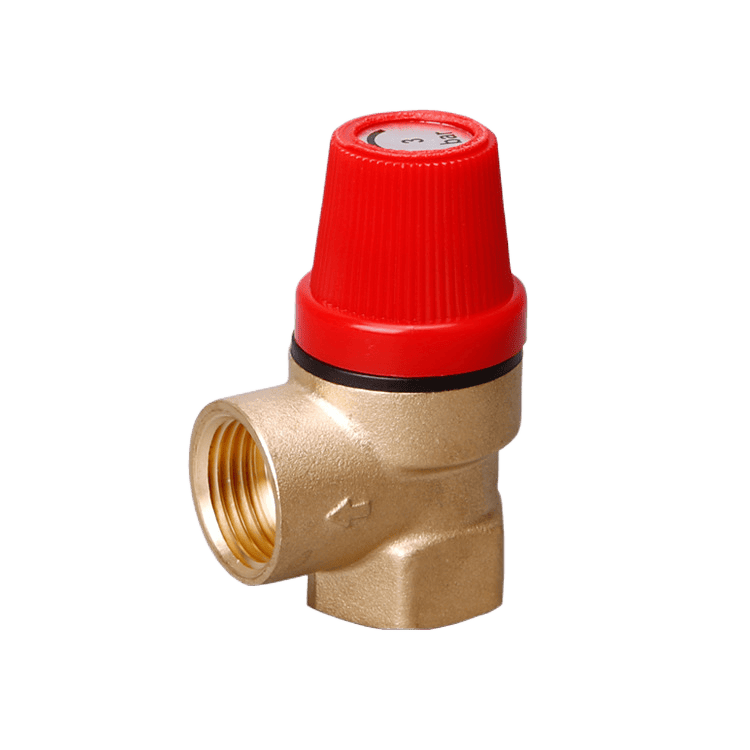Valves are the most crucial plumbing products. We use them everywhere in bathrooms, kitchens, industries, etc. It is impossible to survive without valves. A few decades ago, valves were only supposed to perform functions like regulation and control. But now, they have completely revolutionized the plumbing industry.
There are thousands of different structures, shapes, and sizes for valves. One of those is the thermostatic water valve and brass safety valve. They both are efficient and well-performing. They differ in properties and functions. Below is the difference between a thermostatic water valve and a brass safety valve. Let’s dive straight into it.
What is a Thermostatic Water Valve?
Thermostatic water valves are the ones that can internally sense and control the temperature of the water. Any external power does not guide them. Instead, they have built-in properties to sense temperature changes. Thermostatic water valves contain wax in the valve structure. The wax is sensitive to fluctuation in the temperature of fluid flowing across.
The temperature range for such valves depends upon the wax. We can prepare them in different compositions depending on our desired operating temperature. The wax for thermostatic valves is formulated in manufacturing units under high supervision. Once it is ready, we cannot change its temperature range. It changes when we change its chemical composition.
Thermostatic water valves have three main types. Here are their details for understanding their functions.

Types Of Thermostatic Water Valves:
Thermostatic water valves have three main types depending on their function.
- Thermostatic Mixing Valve: Mixing valves mix hot and cold liquids to moderate levels. They take water from two different inlets. One is having hot and other cold temperatures. It releases them from another outlet with a decreased temperature. Their uses are in homes, schools, hospitals, etc., where body parts can directly contact hot water.
Thermostatic mixing valves also have the same wax composition. It blends hot and cold water to get a specific temperature range. This range depends upon the composition of the wax. Once it reaches the set temperature, it stops the flow of further hot water.

The thermostatic mixing valve contains four essential parts that make up its structure. These are temperature-sensitive elements, pistons, adjusters, and return springs. Here are the specifications of thermostatic mixing valves.
| Specifications Product: Thermostatic Mixing Valve. Material: Brass, H59-1. Thread Size: DN15, DN25. Max Inlet Pressure Ratio: 2:1 Pressure: 5-10 Bar. Max Inlet Temperature: 100°C. Working Temperature: 38 to 46°C. Applications: Bathtub, sink, Basin, Water heater. |
Get thermostatic Mixing Valves here.
- Thermostatic Radiator Valve: These valves regulate the air temperature by controlling the hot water content in the valve. It allows you to attain the desired temperature in rooms or air spaces. They stimulate hot and cold room temperature when it exceeds the set limit. Thermostatic radiator valves are almost effortless ways to control the temperature of a room. It works by creating a bridge between heat radiator and air temperature.
Thermostatic radiator valves are automatic valves having two body parts. The valve head is the upper part, and the valve body is the lower. The head of the valve has a capsule with a pin. The pin comes out, contracting the capsule when the temperature gets low. It increases the amount of hot water in temperature to regulate air temperature. Similarly, when the room’s temperature rises, the capsule expands and takes a pin inside. At this moment, hot water content reduces to decrease temperature.
This mechanism is super quick and self-regulating and works efficiently at a low cost. Let’s check the specifications of thermostatic radiator valves.

.
| Specifications. Product: Brass Thermostatic radiator valve. Material: Forged Brass.Size: 3/8, 1/2 Max Pressure: 1.6MPa Working Temperature: 0 to 120°C. Control Temperature: 0 to 30°C Applications: Hot water operation, heaters, floor heating, etc. |
Get Thermostatic Radiator valves here.
- Thermostatic Expansion Valve: Thermostatic expansion valves are present in refrigerators and chillers. Refrigerant is a fluid present there that moves at high pressure. Expansion valves control the amount of liquid refrigerant and only let a certain amount pass through. They lie near the evaporator, checking the amount of refrigerant from the condenser. Then, they decide how much liquid has to go to the evaporator.
The thermostatic expansion valve has small orifices in the body that control the refrigerant flow. A pin is responsible for changing the size of the orifice. A diaphragm applies pressure on the pin, which decides the size of the orifice inside the valve body.
When a temperature change is sensed, the liquid either expands or contracts. It then releases or stops the refrigerant from releasing into evaporation. Thus, the designated temperature reaches. Here are the specifications of the thermostatic expansion valve.
| Specifications. Product: Thermostatic Expansion Valve. Material: Stainless Steel. Tube Length: 1.5m. Max Pressure: 4.6 MPa Working temperature: -40° to +70°C. Applications: Refrigeration systems, freezers, ice makers, air conditioners, heat pumps, etc. |
What is a Brass Safety Valve?
The brass safety valve is the one that helps to alleviate excessive pressure from a system. The overpressure on a working system can be very harmful. It can cause damage to machinery and the surroundings. The results can be worse in the case of a blast due to High Pressure.
We use brass for safety valves because it is a very durable material. Brass valves possess highly effective properties. We use safety valves in almost every plumbing pressure tube. They maintain smooth pressure by ensuring the safety of the machines.
The structure of the safety valve has a set pressure inside. When pressure exceeds this limit, the valve opens automatically. It then opens completely to release tension from the system. It normalizes the stress and saves spare parts of the system from damage.

Get the Best Safety Valves here.
Types Of Brass Safety Valve:
On an operational basis, Brass Safety valves have the following three types.
- Pilot-Operated Safety Valves: These valves operate in storage tanks and control pressure changes. They often lie at the bottom and help the system achieve a steady temperature.
When the pressure gets higher than the mechanical value of the spring, the safety valve comes into action. Usually, the valve is in a close position, but the pressure increase forces the piston to open it. It then releases the excess pressure. Conventional valves follow this mechanism. The latest works by supplying fluid to the sealing disk. It initiates the opening of the valve, and pressure releases.
These are the specifications of pilot-operated safety valves.
| Specifications. Product: Pilot Operated Safety Relief Valve. Material: Cast Iron. Size: DN20-DN50 Pressure: 1.6MPa Max Temperature: 200°C. Applications: Water Tanks, Water storage, etc. |
- Spring Mechanism Safety Valve: These are conventional types of safety valves. Spring-loaded safety valves have already set the pressure range at which they open. When pressure increases to that limit, the valve opens automatically. It then stops liquid flow from that system to avoid pressure increase.
This type of valve has a body, a nozzle, and an adjusting ring that can adjust the pressure. Compressing spring lies on top of the disc within the bonnet. The nozzle is present beneath the disc and adjusting rings.
Usually, the disc remains fixed on the nozzle as the pressure is within the desired range. But when it detects a significant increase in force, the disc begins to rise, making the spring compress. This condition stimulates the valve opening and treats system stress. Then, it works by cutting fluid supply from that vessel to help the system get stability.

Let’s check out the specs of the spring mechanism safety valve.
| Specifications. Product: High-pressure sealed spring type safety valve. Material: Carbon Steel, copper, stainless steel. Size: 1/2 ×1 inch to 8× 10 inches. Pressure: Non-adjustable, can bear overpressure of 10% other than the fixed range. Max Temperature: 400°C. Applications: Gas, air, steam. |
- Bellow Safety Valve: Bellow safety valves work by controlling the backpressure in a system. Back pressure affects the operational areas of a valve. We can solve this problem by adding bellows to the valve to balance pressure.

Bellows occupy an area similar to an orifice. This zone is out of the effect of back pressure. The bellow zone is air-vented. Only springs are responsible for opposing force when the bellow safety valve is operational. No backpressure is involved in further processing.
Bellow safety valves have the following specifications.
| Specifications. Product: Carbon steel Bellows balanced safety valve. Material: Stainless Steel. Size: DN25-DN200 Pressure: 4MPa. Max Temperature: 200°C Applications: Oil industries, Petrochemical units, etc. |
Difference Between Thermostatic Water Valve and Brass Safety Valve.
| Thermostatic Water Valve | Brass Safety Valve |
| A thermostatic water valve senses and controls the water’s Temperature using internal abilities. | Brass Safety Valves release excess Pressure from a system automatically by sensing changes. |
| They contain wax components within them that sense temperature change. | It has a piston, spring, or bellow to measure pressure fluctuation. |
| The purpose of a thermostatic valve is to normalize the water temperature to make it usable. | Brass Safety Valves release excess pressure from a system automatically by sensing changes. |
| We use brass safety valves to save machines from excess pressure and prevent blasts and explosions. | These valves are insensitive to the water pressure. It means an increase in pressure doesn’t affect their performance. |
| It does not need an external power supply. | Safety valves are also self-actuating valves. |
| Thermostatic mixing valves can bear an inlet pressure of up to 100°C. | The Working Pressure for the Bellow safety valve is 4MPa. |
| The maximum pressure for expansion valves is 4.6MPa. | These valves are the least concerned with temperature changes. They trigger pressure and remain fine even at high Temperatures. |
| Applications.Compressors.Autoclaves.Hydraulic Systems.Distillation Systems.Vacuum Pumps.Steam Boilers. | Applications.Power Plants.Pharmaceutical Plants.Steam Boiler.Industrial Boiler.Refineries.Paper mills. |
Takeaway:
The details above justify the differences between a thermostatic water valve and a brass safety valve. Both have one thing in common: they detect unusual changes. Yet, the thermostatic is temperature-sensitive while the safety valve is Pressure-sensitive. Their types are different in their specific applications.
We can install domestic versions of these valves in our homes. But they are vastly a part of industrial use. You can deeply study each type of valve. It can help you understand which one you should buy per your requirements.